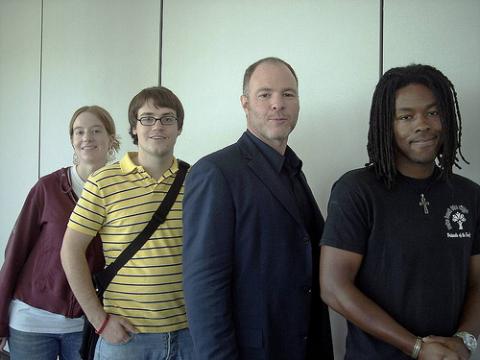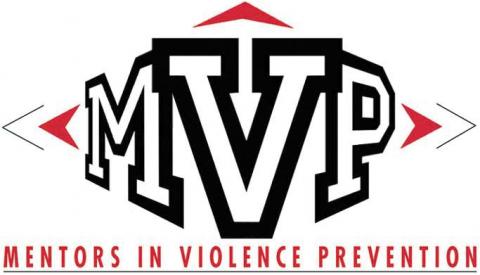Jackson Katz: Violence Against Women Is a Men’s Issue
Jackson Katz, an internationally recognized educator on violence prevention among men and boys, asks why rape is a "women's issue" when over 99 percent of rapes are perpetrated by men.
Jackson Katz, an
internationally recognized educator on gender violence prevention among
men and boys, argues society must first transform how it thinks about
violence against women if it wants to prevent these acts from
reoccurring. "As a culture, Americans first must take the step in
acknowledging that violence against women is not a women’s issue, but a
men’s issue," Katz said. Jackson Katz, Men Against Violence
Jackson Katz, Men Against Violence
"This is the foundation strategy for engaging young men and boys in
gender violence prevention," Katz told an audience of school
counselors, social workers, teachers, University of Iowa psychology students, social
workers, and community members at a forum in Iowa in April. "The first problem I have with labeling gender issues as women’s issues is that it gives men an excuse to not pay
attention. This is also the problem with calling them gender issues,
because the majority of the people in the status quo see gender issues
as women’s issues."
Katz is an educator, author and filmmaker and has been long recognized
as one of America’s leading anti-sexist male activists, in particular
in the sports and military cultures. In 1993 he conceived and
co-founded the Mentors in Violence Prevention (MVP) Program at Northeastern University’s Center for the Study of Sport in Society.
The multiracial, mixed-gender MVP program was the first large-scale
attempt to enlist high school, collegiate and professional athletes in
the fight against all forms of men’s violence against women. Today MVP
is the most widely utilized gender violence prevention program in
college and professional athletics.
 Drawing upon his most recent book, "The Macho Paradox: Why Some Men
Drawing upon his most recent book, "The Macho Paradox: Why Some Men
Hurt Women and How All Can Help," Katz shared some strategies with the
audience, providing them with what he hoped was a foundation they could
build upon in their professional and private lives. "My goal here today
is to give you some concrete strategies on how to approach issues
regarding violence against women and prevent gender-violence issues
among men and young boys."
Katz spent a significant portion of the session driving home his first
strategy and why a paradigm shift in thinking is imperative to the
prevention of gender violence. At the root of the problem is language
and how, historically, language has helped cement and legitimize how
people view gender violence.
Katz used race and gender to illustrate how, over time, language has
helped perpetuate and maintain the dominant culture’s dominance. "In
the United States, when we hear the word `race,’ people generally think
of African Americans," Katz said. "When people hear `sexual
orientation,’ they tend to think that means homosexual, gay, or
lesbian. When people hear `gender,’ they think of women."
"In each, the dominate culture is left out of the equation. This is one
way that dominant systems maintain themselves in that they are rarely
challenged to think about their own dominance," Katz said. "This is one
of the key characteristics of power and privilege and why the dominant
culture has ability to go unexamined and remain invisible."
Katz admits this is one of the key challenges he faces when working
with men, the dominant group in our society. Katz reminds the audience
that his focus is on men. "I hope nobody in this room is under the
delusion that this is sexist," Katz said. "I know women have made great
historical strides in recent history, but when we talk about the
dominant group in our society, we are talking about men. I’m also aware
that members of dominant groups have been strong supporters of
subordinate groups, but let’s not be naïve, for there have been members
of dominant groups who have resisted reform and responsibility."
Another reason why Katz has a problem with people using women’s issues
to describe violence against women is the issue of perpetration and who
is responsible for perpetrating these acts. "Take rape for example,"
said Katz. "Over 99 percent of rape is perpetrated by men, but it’s a
women’s issue?"
Kats said one underlying problem is that college campuses tend to focus
on the prevention of rape and sexual violence. "But the term prevention
in not really prevention; rather, it’s risk reduction," Katz said.
"These programs focus on how women can reduce their chances of being
sexually assaulted. I agree that women benefit from these education
programs, but let us not mistake this for prevention."
"If a woman has done everything in her power to reduce her risk, then a
man who has the proclivity for abuse or need for power will just move
on to another woman or target," Katz added. "It’s about the guy and his
need to assert his power. And it’s not just individual men, it’s a
cultural problem. Our culture is producing violent men, and violence
against women has become institutionalized. We need to take a step back
and examine the institutionalized polices drafted by men that
perpetuate the problem."
The third problem Katz has with using the term women’s issues has to do
with how deeply personal these issues are in men’s lives. "It is
estimated that 18 million women, children, and men have been sexually
abused in the U.S.," Katz said. "Think about all the men who love these
people and have been personally and profoundly affected by knowing that
their loved ones have been a victim of sexual violence. So don’t tell
me these are not men’s issues."
Katz’s second strategy for addressing gender violence demands that we
hold male leaders accountable, since they have the transformative power
within the institution to make change happen. "I come from a social
justice perspective that if you are a member of the dominant group and
you don’t speak up in the face of others in your group when they are
abusive, your silence is a form of consent and complicity."
Katz says the mainstream media should also be held accountable for its
silence in the realm of reporting on gender violence. "On the one-year
anniversary of the Virginia Tech massacre, the coverage of the event
was pathetic, not to mention the commentary was ridiculously
superficial," Katz said. "There was not one mention of men,
masculinity, or violence in their coverage, yet all of these school
shootings have been perpetrated by young men. The first thing we should
be talking about is the gender of the perpetrators, not gun control,
school security, and the school’s responsibility."
Moreover, Katz used Michael Moore’s documentary film, "Bowling for
Columbine," to help support his point about the de-gendering of
violence perpetrated by men. "Moore’s documentary about the Columbine
shootings won several awards, including an Oscar for Best Documentary,"
Katz said. "He makes a two-hour film about gun violence; however, he
doesn’t once mention the single most important factor leading to the
shooting: gender."
Katz points out a pattern that has evolved regarding how the media uses
passive voice and sentences when reporting gender violence. Using a
board in the front of the room, Katz helped make his point by providing
the audience with a concrete exercise to illustrate the power of
passive voice (see below).
John beat Mary. (active)
Mary was beaten by John. (passive)
Mary was beaten. (passive)
Mary was battered. (passive)
Mary is a battered woman. (active)
"John has left the conversation long ago, while Mary evolves into the
active victim," Katz said. "This evolution of victim-blaming is very
pervasive in our society, because this is how our whole power structure
is set up. We start asking why Mary put herself into a position to be
beaten by John."
"If we really want to work on prevention, we need to start asking
questions about John, not Mary," Katz said. "We won’t get anything done
until we start treating these issues as men’s issues and shift the
paradigm at the cultural level."
